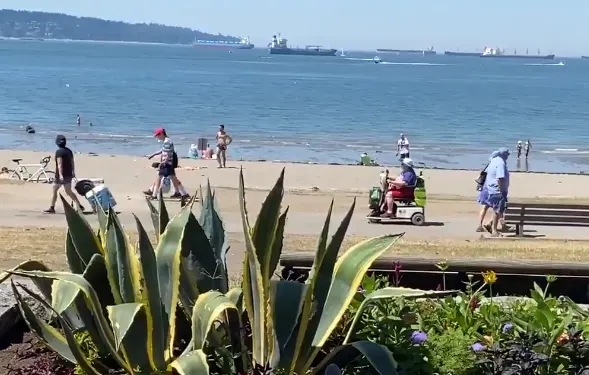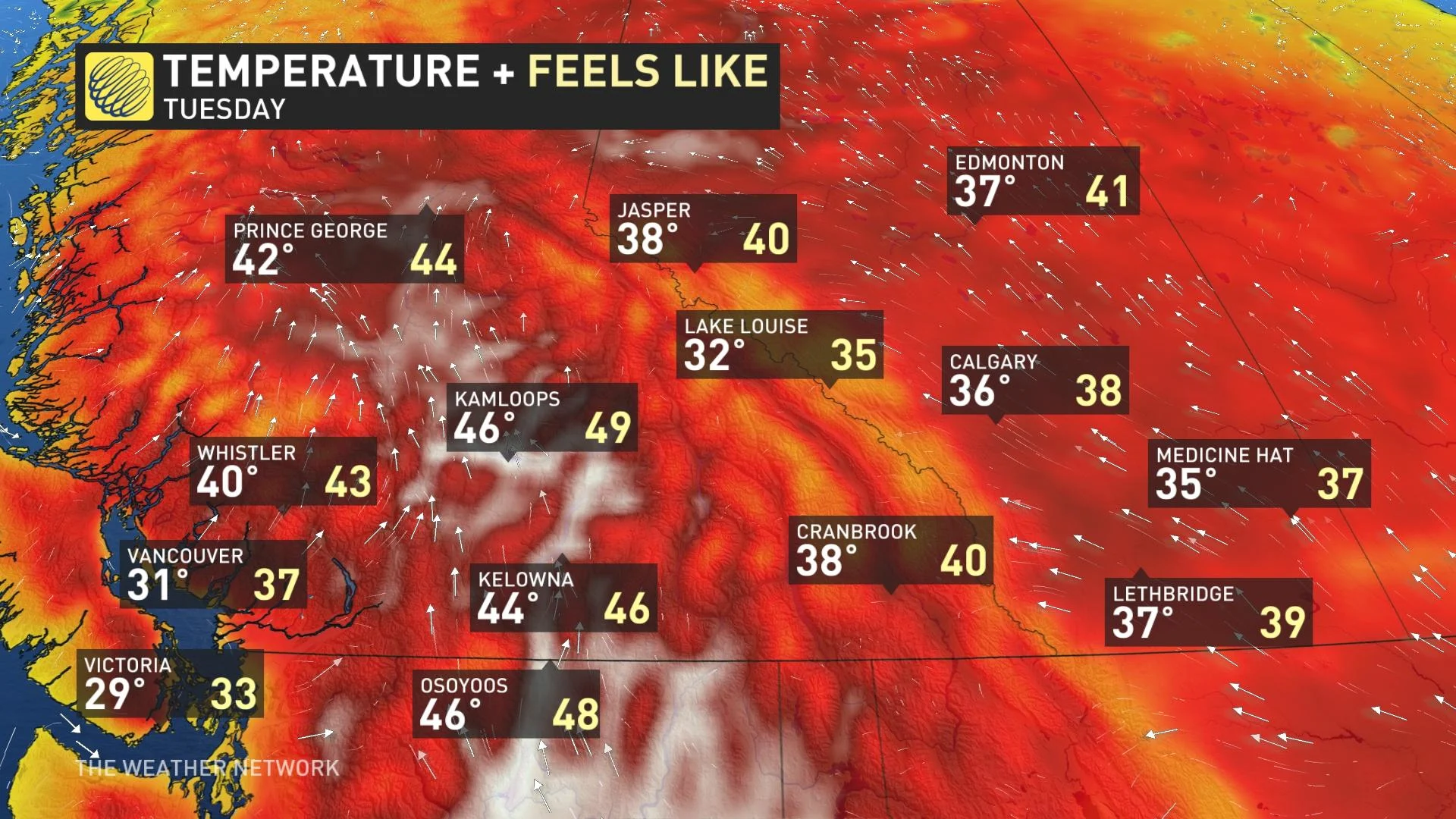
'Off the charts' heat wave continues to stifle Western Canada
A prolonged 'heat-dome' event is yielding record-shattering temperatures to much of the Western Canada, with parts of B.C. smashing all-time Canadian records. Residents are reminded to exercise caution and help prevent any human-caused wildfires from igniting. Here’s what you need to know.
The intense heat wave that is blanketing Western Canada with dangerously stifling conditions will continue for a few more days. Meteorologists warn that temperatures will be even hotter than those record-setting daytime highs felt on the weekend, with overnight lows even staying above the 20-degree mark.
Since Friday, several all-time and/or monthly highs, as well as dozens of daily records have been broken. One of them was the hottest temperature ever recorded in Canada.
"Lytton became a temporary holder of Canada’s warmest temperature in history on Sunday when the city unofficially hit 46.6°C, but that will likely be surpassed on Monday, potentially at the same station," says Tyler Hamilton, a meteorologist at The Weather Network.

The historic heat is the result of what's colloquially referred to as a heat dome, something more common to the southwestern U.S. It's an area of intense high pressure, beneath which descending air compresses into layers near the surface, warming drastically as it does so.
This heat dome is creating a feedback loop: The warm air gets trapped in the lower elevations, and temperatures can only fall into the 20s at night. The following days can be incrementally toastier.
RELATED: Open burning to be banned across B.C. as heat wave hits
The good news for sun-lovers is that such features tend to be marked by clear skies, inhibiting the kind of vertical motion that produces clouds. It also keeps out low-pressure systems that can bring rain and thunderstorms. But the downside is that the dry conditions coincide with periods of drought conditions and an elevated fire danger.
See below for a look at the forecast conditions meteorologists are expecting this week.
MONDAY - WEDNESDAY: HISTORIC WARMTH BREAKS RECORDS
Monday morning will be warmer than the average daytime high for the end of June - bottoming out as high as 26 or 27°C. Some schools shut their doors Monday morning because of the extreme heat, with information about Tuesday classes to be released on Monday.

A thermal trough – a thin, weak area of low pressure – tends to develop along the B.C. coast during these heat events, enhancing the offshore flow and allowing the air to further warm as it snakes down from the coastal mountains. The thermal trough will push coastal sections to their warmest temperatures in recorded history.
Many communities have opened cooling centres and other measures to keep the public safe. Power grids are taking significant hits and a lack of rain in the forecast means the fire danger is on the rise.
"Climate change has altered our atmosphere, and I’m forecasting all-time temperature records on Vancouver Island - similar to levels seen in Dubai or Phoenix, Arizona," says Hamilton.
WATCH: WARMEST DAY IN HISTORY COMING TO VANCOUVER ISLAND
Alberta won't quite reach such extreme levels as B.C., but daytime highs in the upper 30s to low 40’s will be widespread and deeply uncomfortable, even when the humidity eases off.
It's likely that the dangerous heat wave will continue into Thursday. The heat will also spread into Saskatchewan, with daytime temperatures pushing the mid-to-upper 30s by Tuesday.
Temperatures will even soar into the low 40’s in sections of the Northwest Territories on Wednesday, a testament to the record-setting nature of this ridge.
For some relief, head down to the Pacific Ocean, but it remains to be seen if the daytime sea-breeze will push very far inland, at all. Your best bet is to be directly in the ocean, or somehow find your way to Prince Rupert.

HEALTH IMPACTS
The extreme heat should be taken seriously as it could harm your health and cause heat-related illnesses.
“Heat-related illness is the result of your body gaining heat faster than it can cool itself down,” states HealthLink BC on their website. “Those at increased risk for heat-related illness include: infants and children, people 65 years of age or older, and people who do a lot of physical activity or work in a hot environment. In most cases, heat-related illnesses are preventable.”

Heat stroke is a life-threatening medical emergency. Call 9-1-1 or other emergency medical services as soon as you suspect or see the signs of heat stroke in an individual. Click here to learn more about heat stroke.
Heat stroke shares some symptoms with heat exhaustion, but the most acute to watch out for (according to Canadian Centre for Occupational Health and Safety) are:
Hot, dry skin or profuse sweating
Confusion
Loss of consciousness
Seizures
Very high body temperature
Heat stroke can follow on from untreated heat exhaustion, or can happen without little or no warning. To learn more about how extreme heat can impact the human body, click here.
HUMID VS. DRY HEAT: WHY THE DIFFERENCE MATTERS
RELATED: Climate change boosted heat deaths by more than a third
HUMAN-CAUSED FIRES A BIG CONCERN
The heat has also ignited fears of human-caused wildfires. The B.C. Wildfire Service says nothing larger than a campfire will be allowed across the province as scorching temperatures are expected to ramp up.
Residents are urged to exercise caution when outdoors. There are numerous ways human activity can start wildfires, some of which include open burning, the use of engines or vehicles, dropping burning substances such as cigarettes or the use of fireworks. The most important factor of person-caused fires is that they are preventable.
Residents are also reminded to check with local authorities before lighting a fire of any size.
Click here for current fire bans and restrictions in Alberta
Click here for current fire bans and restrictions in Saskatchewan
Click here for wildfire updates in the Northwest Territories
ADDITIONAL SAFETY MEASURES IN VANCOUVER
The City of Vancouver has implemented additional measures to protect residents facing compounded challenges of COVID-19 and the heat. Some of which include:
Community centres in the Downtown Eastside will offer water to patrons requesting it or in need of hydration, as well as supporting patrons with sun block. If you are out and about, you can fill up your water bottle at one of over 200 drinking fountains.
The City’s Non-Market Housing Operations is implementing a hot weather support plan for tenants, which includes increased wellness checks, and provision of bottled water and table-top fans for those residents not able or wanting to leave their rooms. Additionally, air-conditioned common area spaces will be available for residents to seek respite from the heat. Residents can find a list of the City’s 10 air-conditioned community centres and all library locations have air-conditioning at vancouver.ca/hot-weather.
Sharing heat safety messaging with operators of many of Vancouver’s SROs and requesting that they check on residents who are vulnerable to heat.
Emergency service personnel and volunteers will be vigilant for people who may be suffering from or are at risk of heat exposure.
The city will be providing additional information via Vancouver.ca to ensure people are aware of heat warnings and can access the information they need.
Be sure to check back as we continue to monitor this potentially life-threatening heat wave.
